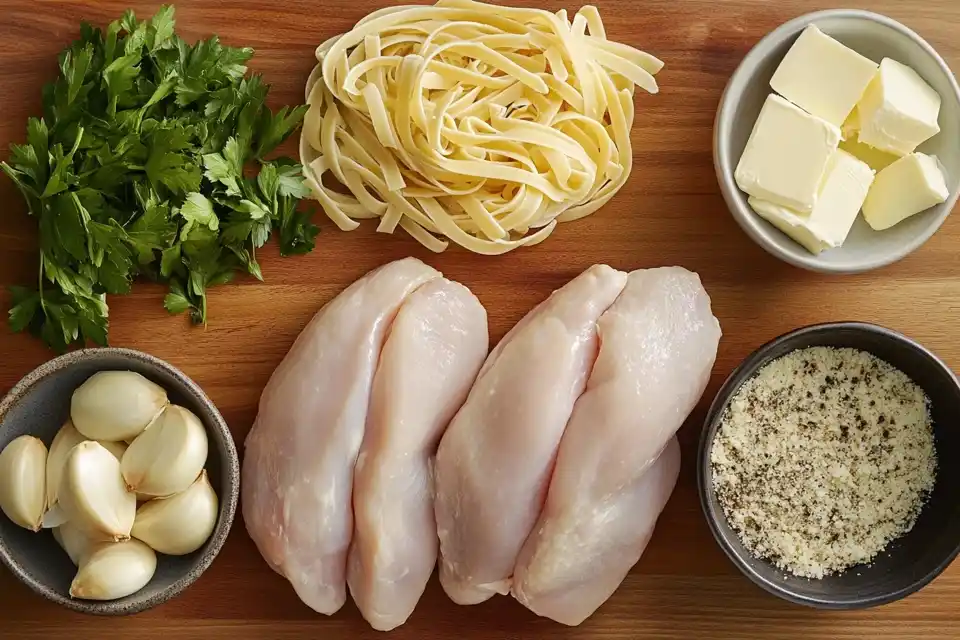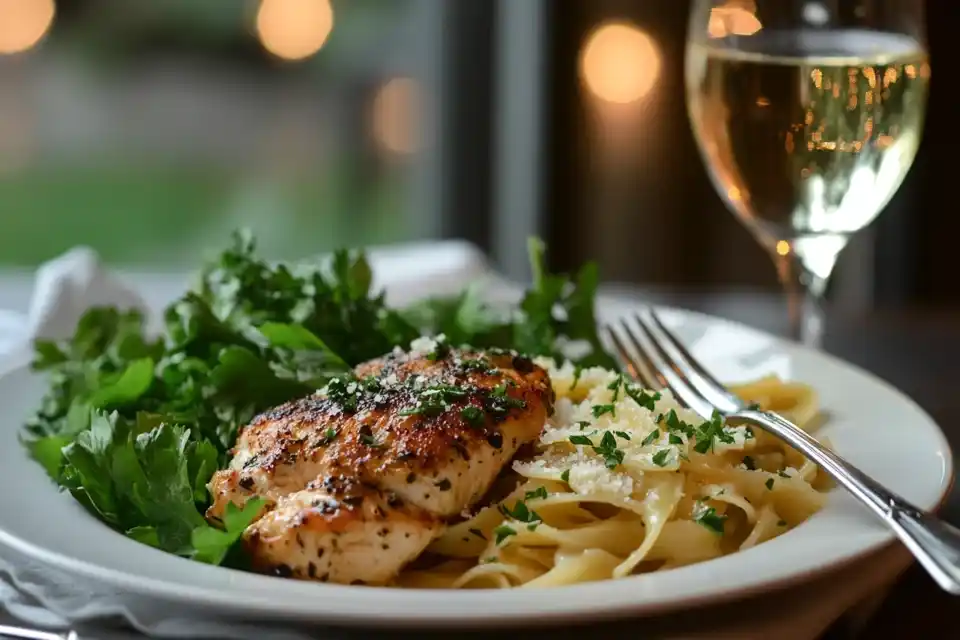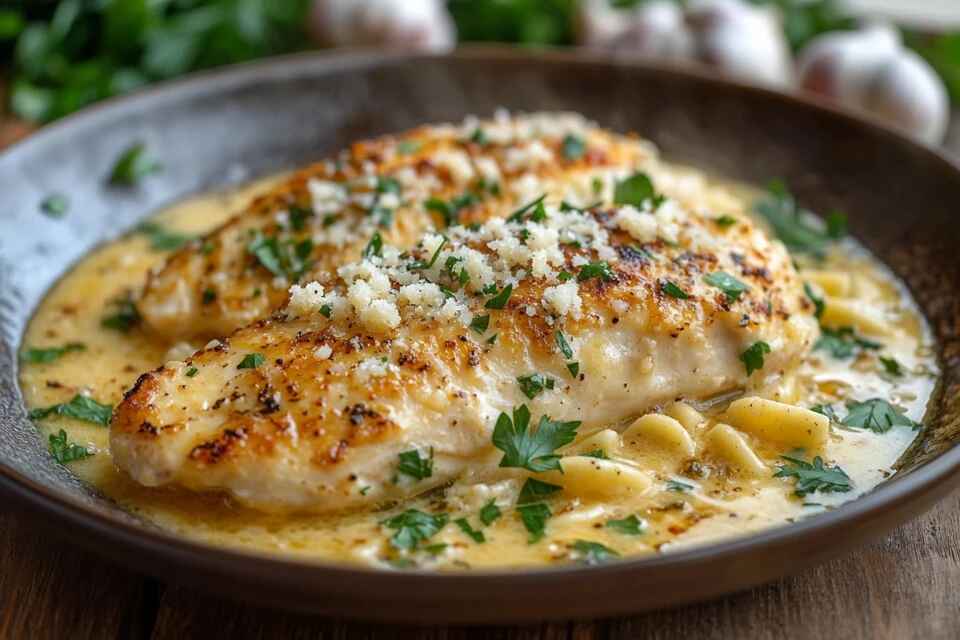If there’s one dish that never fails to hit the spot, it’s Garlic Parmesan Chicken Pasta. It’s creamy, cheesy, garlicky, and packed with tender, juicy chicken—basically, comfort food at its finest. Whether you’re cooking for a busy weeknight dinner, a cozy date night, or a family gathering, this dish never disappoints.
But here’s the thing—making the perfect Garlic Parmesan Chicken Pasta isn’t just about throwing some ingredients together. You need to know the right techniques, the best ingredient choices, and a few tricks to avoid common cooking mistakes.
In this guide, I’ll walk you through everything: the ingredients, step-by-step cooking instructions, common pitfalls, variations, and even what to serve with it. By the end, you’ll have all the knowledge you need to cook this dish like a pro! Let’s dive in. 🚀
Table of Contents
Garlic Parmesan Chicken Pasta
What makes Garlic Parmesan Chicken Pasta so special? Well, let’s break it down:
✅ Flavor Explosion: The combo of roasted garlic, savory parmesan cheese, and creamy sauce creates an irresistible taste.
✅ Easy to Make: You don’t need to be a pro chef—just follow a few simple steps!
✅ Customizable: Whether you like it spicy, extra cheesy, or packed with veggies, this dish is super versatile.
✅ Filling & Satisfying: With protein from the chicken, carbs from the pasta, and fats from the creamy sauce, this dish is a whole meal in itself.
If you love pasta dishes like Alfredo or Carbonara, this one is definitely for you.
Why Garlic Parmesan Chicken Pasta is So Popular?
A Perfect Blend of Flavors
What’s better than garlic and parmesan? Not much! Garlic brings that deep, rich, slightly sweet flavor when cooked properly, while parmesan adds a nutty, salty kick that makes every bite delicious. Combine that with juicy chicken and silky pasta, and you have the perfect balance of flavors.
Love garlic? Learn more about making the ultimate Parmesan Garlic Sauce that pairs well with pasta, chicken, and even pizza!
A Quick and Easy Meal for Any Occasion
Some pasta dishes take forever to make, but not this one. In less than 30 minutes, you can have a restaurant-quality meal right at home. It’s the kind of dish that looks fancy but requires very little effort—perfect for impressing guests or treating yourself after a long day.
Essential Ingredients for Garlic Parmesan Chicken Pasta

Let’s talk ingredients! Choosing the right ones can make a world of difference. Here’s everything you need:
Choosing the Best Chicken
You can use chicken breasts or chicken thighs for this recipe. If you want lean and firm meat, go for chicken breasts. But if you prefer juicier and more flavorful chicken, boneless, skinless thighs are the way to go.
The Role of Garlic in Enhancing Flavor
Garlic is the star of the show here. Fresh garlic is a must—skip the pre-minced stuff from the jar. Want extra depth? Try roasting your garlic before adding it to the sauce.
Parmesan Cheese: The Secret to Creamy Goodness
A good-quality parmesan cheese (like Parmigiano-Reggiano) makes a huge difference. Avoid the powdered parmesan in a can—it won’t melt properly or give you that rich, nutty flavor.
Best Pasta Options for This Dish
Not all pasta is created equal! Here are your best choices:
- Fettuccine: Classic choice for creamy sauces.
- Penne: Holds the sauce well with its tube shape.
- Linguine: A slightly thinner alternative to fettuccine.
- Rotini: Great for trapping sauce in its spirals.
Additional Ingredients for Extra Flavor
Want to take your dish up a notch? Here are some bonus add-ins:
- Red pepper flakes for a spicy kick
- Fresh basil or parsley for freshness
- Mushrooms for an earthy, umami taste
- Sun-dried tomatoes for a sweet-tangy balance
If you’re out of parmesan, check out this guide on parmesan substitutes to find the best alternatives!
Step-by-Step Recipe: How to Make Garlic Parmesan Chicken Pasta

Now that we’ve covered the essentials, let’s get cooking! Here’s what you’ll need:
Ingredients List
| Ingredient | Quantity |
|---|---|
| Chicken breast or thighs | 2 pieces (sliced) |
| Pasta (Fettuccine, Penne, or Linguine) | 12 oz |
| Fresh garlic | 6 cloves (minced) |
| Butter | 2 tbsp |
| Olive oil | 2 tbsp |
| Heavy cream | 1 cup |
| Milk | ½ cup |
| Parmesan cheese (grated) | 1 cup |
| Chicken broth | ½ cup |
| Italian seasoning | 1 tsp |
| Red pepper flakes (optional) | ½ tsp |
| Fresh parsley (for garnish) | 2 tbsp |
| Salt & black pepper | To taste |
Step 1: Prepping the Chicken
1️⃣ Season the chicken with salt, pepper, and Italian seasoning.
2️⃣ Heat 1 tbsp olive oil and 1 tbsp butter in a pan over medium heat.
3️⃣ Sear the chicken for about 4-5 minutes per side until golden brown and fully cooked.
4️⃣ Remove from the pan and set aside.
🔹 Pro Tip: Let the chicken rest for 5 minutes before slicing. This keeps it juicy!
Step 2: Cooking the Garlic Parmesan Sauce
1️⃣ In the same pan, melt another 1 tbsp butter and add minced garlic. Sauté until fragrant (about 30 seconds).
2️⃣ Pour in chicken broth, heavy cream, and milk, stirring constantly.
3️⃣ Reduce heat and add parmesan cheese slowly, stirring until melted.
4️⃣ Sprinkle in red pepper flakes (if using) for a little heat.
🔹 Pro Tip: If the sauce gets too thick, add a splash of milk. If it’s too thin, let it simmer longer!
Step 3: Cooking the Pasta & Bringing It All Together
1️⃣ Cook pasta according to package instructions (don’t overcook!).
2️⃣ . Drain and immediately toss into the creamy sauce.
3️⃣ . Add the sliced chicken on top and mix everything together.
4️⃣ Garnish with fresh parsley and extra Parmesan.
And there you have it! A creamy, dreamy plate of Garlic Parmesan Chicken Pasta.
“Cheese makes everything better, but garlic makes it unforgettable.” – Every Italian Chef Ever
Common Problems and Solutions When Making Garlic Parmesan Chicken Pasta
Even though this dish is easy to make, small mistakes can ruin the texture or flavor. But don’t worry—I’ve got you covered! Here are some of the most common issues and how to fix them:
Why Is My Sauce Too Thin or Too Thick?
✅ If it’s too thin:
- Add more parmesan cheese to thicken the sauce.
- Let it simmer longer so the liquid can reduce.
- Mix 1 tsp of cornstarch with a little water and stir it in.
✅ If it’s too thick:
- Add a splash of milk or chicken broth to loosen it.
- Avoid adding too much parmesan at once—it can clump and make the sauce overly thick.
“The perfect sauce is like a good conversation—smooth, rich, and never too overwhelming.”
How to Prevent Overcooked or Dry Chicken
There’s nothing worse than tough, rubbery chicken in a creamy pasta dish. Here’s how to keep it juicy:
- Don’t overcook it! Chicken should be cooked until just done (internal temp of 165°F/75°C).
- Let it rest for 5 minutes after cooking—this locks in the juices.
- Slice against the grain for a tender bite.
Fixing a Bland-Tasting Pasta Dish
If your Garlic Parmesan Chicken Pasta tastes a little… meh, here’s how to boost the flavor:
- Add a pinch of salt—seasoning is key!
- Use fresh garlic instead of garlic powder for a more intense taste.
- A squeeze of lemon juice can brighten up the flavors.
- Add red pepper flakes for a spicy kick!
Pro Tip: Always taste your sauce before serving! If it needs a little something, it’s probably salt or acidity.
How to Make It Less Greasy or Heavy?
If your sauce feels too oily or heavy, try these tricks:
- Swap out heavy cream for half-and-half or whole milk.
- Use Greek yogurt instead of some of the cream for a lighter version.
- Avoid too much butter—a little goes a long way!
Variations and Customizations of Garlic Parmesan Chicken Pasta
One of the best things about this dish? It’s super customizable! Here are some fun variations:
Healthy and Low-Calorie Modifications
Want to enjoy this dish without the guilt? Try these swaps:
✅ Use whole wheat pasta or zucchini noodles instead of regular pasta.
✅ Replace heavy cream with evaporated milk or Greek yogurt.
✅ Use grilled chicken instead of pan-fried to reduce oil.
Spicy Garlic Parmesan Chicken Pasta
Love a little heat? Here’s how to spice things up:
Add 1-2 teaspoons of red pepper flakes to the sauce.
Mix in cayenne pepper for extra fire.
Try spicy Italian sausage instead of chicken.
Adding Vegetables for Extra Nutrition
Want to make this dish healthier and more colorful? Toss in some veggies!
Broccoli – Pairs perfectly with creamy sauce.
Mushrooms – Adds a rich, earthy flavor.
Sun-dried tomatoes – A little tangy and sweet.
Spinach – Wilts beautifully into the sauce.
Pro Tip: Add veggies in the last few minutes of cooking so they stay fresh and vibrant.
Using Different Types of Protein (Shrimp, Tofu, etc.)
Not in the mood for chicken? No problem! Try these options:
Shrimp: Cooks quickly and adds a seafood twist.
Bacon or Pancetta: Adds a smoky, salty kick.
Tofu: A great vegetarian alternative—just season it well!
“The best pasta is the one that fits your cravings.”
Best Side Dishes to Serve with Garlic Parmesan Chicken Pasta

Sure, this dish is amazing on its own, but adding a side dish takes it to the next level! Here are some great pairings:
Garlic Bread: The Classic Companion
Nothing beats crispy, buttery garlic bread alongside creamy pasta. Try making your own:
Mix butter, minced garlic, and parsley, then spread it on French bread.
Toast in the oven at 375°F (190°C) for 10 minutes until golden brown.
Fresh Salads for a Balanced Meal
A light salad helps cut through the richness of the pasta. Here are some great options:
Caesar Salad – Crunchy romaine, parmesan, and croutons.
Arugula Salad – Peppery arugula, cherry tomatoes, and balsamic.
Lemon Vinaigrette Salad – Mixed greens with a zesty dressing.
“A fresh salad is like a reset button for your taste buds.”
Wine Pairing Suggestions
Want to elevate your meal? Pair your pasta with the perfect wine! 🍷
Chardonnay – Its creamy texture matches the sauce beautifully.
Sauvignon Blanc – Crisp and refreshing, great for cutting through richness.
Pinot Grigio – Light and citrusy, complements the garlic flavors.
Pro Tip: Not a wine drinker? A cold glass of lemon-infused water is just as refreshing!
Nutrition Facts (Per Serving)
| Nutrient | Amount |
|---|---|
| Calories | ~600 kcal |
| Protein | 35g |
| Carbs | 50g |
| Fats | 30g |
| Fiber | 3g |
| Calcium | 20% DV |
Note: Values may vary depending on ingredients used.
Storing and Reheating Garlic Parmesan Chicken Pasta
One of the best things about this dish? It makes great leftovers! But if you don’t store or reheat it correctly, you might end up with dry chicken and clumpy pasta. Here’s how to keep it fresh and delicious.
Proper Storage Techniques
If you have leftovers, follow these simple steps to keep them fresh:
✔️ Cool it down first – Let the pasta come to room temperature before storing.
✔️ Use an airtight container – This prevents the pasta from drying out.
✔️ Refrigerate properly – Store in the fridge for up to 3 days.
✔️ Freeze for long-term storage – Place in a freezer-safe container for up to 2 months.
Pro Tip: If you plan to freeze it, separate the sauce from the pasta. This helps maintain the best texture when reheating!
Best Ways to Reheat Without Losing Flavor
No one likes dried-out chicken or sticky pasta. Here’s how to reheat it like a pro:
On the Stovetop (Best Method!)
1️⃣ Add a splash of milk, chicken broth, or cream to a pan.
2️⃣ Heat over medium-low and stir occasionally.
3️⃣ Add a bit of butter or olive oil to bring back the richness.
In the Microwave (Quick but Risky)
1️⃣ Place pasta in a microwave-safe dish.
2️⃣ Add a little milk or broth to prevent drying out.
3️⃣ Cover with a damp paper towel and microwave in 30-second bursts, stirring in between.
In the Oven (Great for Big Batches)
1️⃣ Preheat oven to 350°F (175°C).
2️⃣ Place pasta in an oven-safe dish and add a little liquid.
3️⃣ Cover with foil and bake for 10-15 minutes.
“The secret to great leftovers is a little extra love when reheating.”
Frequently Asked Questions About Garlic Parmesan Chicken Pasta
Got questions? You’re not alone! Here are some of the most common questions people have about this dish.
Can I Make It Ahead of Time?
Yes! If you’re meal-prepping or cooking for a gathering, you can make this ahead. Just store the sauce and pasta separately, then mix them when reheating for the best texture.
Can I Use a Different Cheese Instead of Parmesan?
Absolutely! While parmesan is the classic choice, here are some alternatives:
Pecorino Romano – Saltier and sharper than parmesan.
Grana Padano – Similar to parmesan but milder.
Asiago – Adds a slightly tangy flavor.
Is This Recipe Gluten-Free? How to Make It Gluten-Free?
By default, this recipe isn’t gluten-free, but you can easily modify it:
Use gluten-free pasta (like rice or chickpea pasta).
Make sure your chicken broth is gluten-free.
Use a gluten-free thickener (like cornstarch) instead of flour.
Pro Tip: The sauce itself is naturally gluten-free, so just swap the pasta!
Can I Make This Without Heavy Cream?
Yes! If you want a lighter version, try these substitutes:
Half-and-half – Less fat, but still creamy.
Whole milk – Lighter but may need extra cheese for thickness.
Greek yogurt – Adds a tangy twist and extra protein.
“Creamy pasta doesn’t have to be heavy—you just need the right balance.”
Conclusion: Enjoy Your Homemade Garlic Parmesan Chicken Pasta
And there you have it! You’re now officially a Garlic Parmesan Chicken Pasta expert.
Let’s recap what we covered:
✅ The perfect balance of flavors – Garlic, parmesan, and creamy goodness.
✅ Step-by-step recipe guide – Foolproof instructions for success.
✅ Troubleshooting tips – How to fix thin sauce, dry chicken, or bland pasta.
✅ Creative variations – Spicy, healthy, veggie-packed, and more!
✅ Storage & reheating tips – Keep leftovers fresh and delicious.
Now it’s time to grab your ingredients, fire up the stove, and create some magic in your kitchen!
“Cooking is like love—it should be entered into with abandon or not at all.” – Harriet Van Horne
Let me know if you try this recipe! I’d love to hear how it turned out. Happy cooking!

